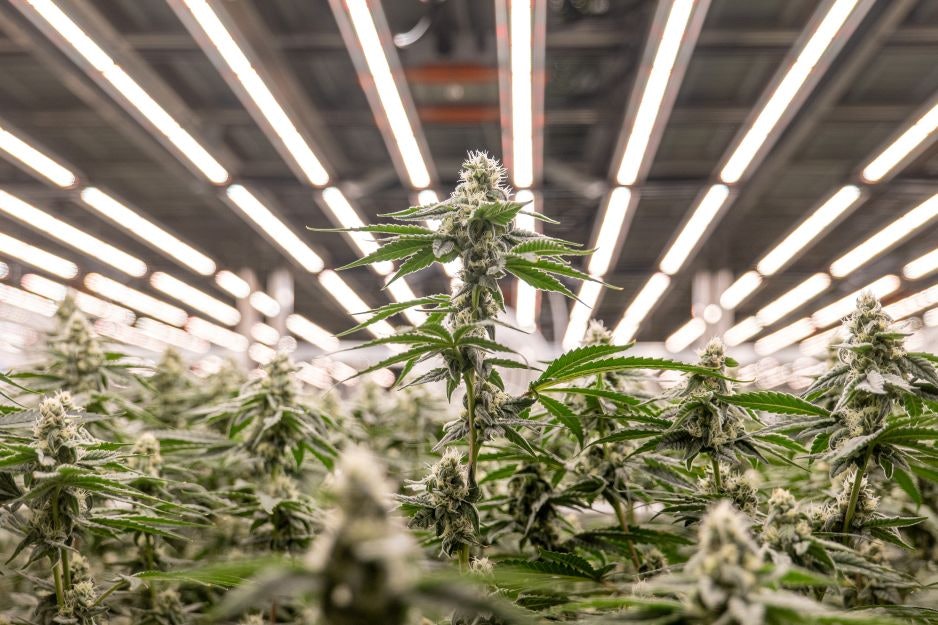On the surface, King City Gardens may seem like other successful up-and-coming cannabis operations. The Cincinnati-based company cultivates 25,000 square feet of double-tiered canopy within an 88,000-square-foot footprint, giving them plenty of room to grow.
But dig a little deeper, and you’ll discover the path to where they are today was anything but easy. In their quest to cultivate premium craft cannabis “on a grand scale,” the challenges the King City team had to overcome were grand as well.
Entering the Market in Record Time
King City Gardens managing member Bill Foster had his eye on Ohio’s cannabis potential 10 years ago, as the state moved toward its failed ballot initiative in 2015. It would take six years, state approval of a medical marijuana program, two denied cultivation applications, and litigation challenging the denials before Foster and his group prevailed and won their license.
While the 2021 milestone was cause for celebration, it came while global supply chains were still reeling from COVID-19. Ohio regulators gave King City a nine-month timeline to become operational, but the team pushed back and won some flexibility when that timeline would start in light of the pandemic’s impact.
It was May 2022 before they found a location. Six more months passed before they had their architect and engineer. When they broke ground in January 2023, the countdown began, and King City wasted no time; the business was operational by Aug. 15, 2023.
“We were aggressive in pushing to get the goal accomplished, which was to get open,” says Foster, a seasoned executive in the warehousing industry. “We were already four years behind the industry here in Ohio, so we had some catching up to do.”
Though King City’s construction timeline was impressive under normal circumstances, it’s even more remarkable given additional hurdles the company faced.
Overcoming Supply Chain Challenges
Sourcing equipment turned out to be the biggest challenge the King City team faced in meeting Ohio’s mandated timeline. With supply chains unpredictable at best, they were pressed to be creative in securing whatever equipment they could to avoid a two-year lead time on what they were looking to buy.
“We purchased all of our equipment—our lights, our HVAC—before we designed our facility, because we were bound by the supply that was there or what was available to us. So we had to engineer it backwards,” Foster recalls.
HVAC was the toughest buy. The company pieced together units from five different HVAC suppliers. “Then we had to try and find a software that would integrate with them all, so that we could use the designs and software that we wanted to use to control our systems,” Foster says.
King City Vice President of Operations Richard (Rick) Mursinna, Ph.D.—who has worked with Foster for more than 20 years in other businesses—adds, “We have nearly 100 tons of HVAC for each of our grow rooms. Ideally, we would have one unit or something similar where Room 1 and Room 2 look the same. One of the challenges is none of our rooms are the same, because we had to pick up a 10-ton here, a 30-ton there, a 50-ton here, and make it work.”
Conquering Commissioning Challenges
Operational issues and commissioning problems came next. “From an owner and operator perspective, in the beginning, we didn’t know what we didn’t know,” Foster says. “We invested heavily into the facility, but we didn’t know how the supply of HVAC was going to play with our dehumidification that we had put in each room.”
The initial goal was to equip as many rooms as possible, then go through gradual commissioning of all the equipment to see what they had, understand the parameters, and discover what was or wasn’t functioning for the rooms.
The King City team started with six rooms in cultivation. Each room has 2,883 square feet of canopy on double tiers built 6 feet apart to optimize airflow and mitigate microclimates.
The idea was they’d take the subpar product they expected and send it for extraction. They’d focus on the data points they’d accumulate to start tweaking performance of the rooms.
That idea didn’t last. All six rooms unexpectedly graded at 28% THC or higher, some with 6% terpenes. So, the team fired everything up. Then reality struck in the form of malfunctions, faulty valves, and other problems with equipment that wasn’t commissioned properly.
Mursinna explains, “We were dealing with so many contractors at the exact same time. Trying to install the lights at the same time as the fertigation, at the same time as the walls and ceilings. Everyone was crossing paths, so commissioning didn’t happen properly.” So, despite their investment and what they felt was a “beautiful layout” for optimizing cultivation and workflow, when the team turned all the equipment on at once, the malfunctions and problems occurred.
And so, the process began again.
Building Trust and a Team
Another major operational challenge came with labor. Initial plans for the King City Gardens facility called for quickly ramping from 100 to 150 employees. But Ohio had a very rigorous and time-consuming system of background checks, fingerprinting, and other requirements for employee candidates for cannabis facilities. Review times of 60 days were standard. Most applicants moved on by the time they were cleared.
King City launched with 10 employees in the first six rooms, with everyone including the owners pitching in, from trimming and topping to packaging.
As the company was able to bring on more employees, another challenge arose: trust between employees from cannabis backgrounds and businesspeople accustomed to a different culture.
“In this industry, blending professionalism and/or business acumen with culture and growers—mostly passionate, ‘boutique-style’ growers—it was a very difficult thing to gain trust from one another,” Foster shares.
Referencing a key cultivation employee as an example, Foster says it took a long time to earn that person’s trust due to a situation that person had with a previous employer.
“The relationship that had been provided to him prior to employment with us made him very hesitant on trusting anyone with business acumen, because people simply just weren’t upholding their promises,” Foster says.
Foster says that he overcame the lack of trust with that employee by not overpromising and keeping the promises he made. “Fulfilling that promise is very easy in this world to do, because if you don’t fulfill a promise, you don’t have staff,” he adds.
Reflecting on Lessons Learned
Looking back on the journey from litigation to licensing to operations, Foster and Mursinna note they’ve learned multiple lessons along the way.
“We would have definitely done a little bit more homework on contractors and vetted them a little bit more,” Foster says. “Not to say that they weren’t qualified or did not do a good job, because they did, but none of our contractors had ever done a marijuana facility or, [for that matter], a medical grade facility, and that to me is critical because of the commissioning and the things that we learned after.”
To summarize, he adds: “Save your money on materials you buy. Save your money on negotiating some of the equipment that you’re planning on using. But don’t skim on the contractors and the buildout.”
One bright spot in the process was the team’s experience with their lighting solutions provider. Foster and Mursinna met the Fluence team at their first cannabis industry trade show. They had already decided on LEDs. But some lighting suppliers in the running didn’t have the 2,000 lights King City needed.
“Fluence stood pretty tall,” Foster says. “They had supply. They guaranteed the service behind it. And I have to say, I’m in distribution and so I’m dealing with suppliers all the time, and they were one of my most favorite to deal with.”
Foster notes that the Fluence team also came on site and helped King City’s installers install the lights and understand the proper design, use and set up. “And Fluence has done very well in their follow-up, too. They visit the site once every three to six months to see how things are going,” he says.
Planning a Grand Future
Looking to what’s next for King City Gardens, Mursinna draws on his decades working with Foster before they added cannabis to their slate. What started with one Kentucky warehouse in that business has grown into a warehousing and distribution business with a square footage footprint in the millions.
“That really is our vision with King City,” Mursinna says. “We right now have one facility. I’m going to call it a small facility, even though it’s the biggest facility I’ve ever been in. We’re going to grow in Ohio. We’re going to become the best in Ohio. When it does become federally legal, when borders drop, by then we should have a good name in multiple states of who we are, and we’re going to take over the United States, just like we did in the warehouse industry.”
For Foster, the most important achievement is that the facility is seeing exceptional quality and yields. “Our whole design was meant to have craft cannabis at scale, and I feel that we’ve accomplished that,” he says.
More from our latest newsletter:
Sponsored: How to (Accurately) Calculate ROI on Your Lighting Retrofit
Sponsored: The Highest Output SPYDR Ever: SPYDR 2h
The cultivator battled supply chain woes, tight regulatory deadlines, labor hurdles and more to break into Ohio’s market — here’s what they learned. Read More


